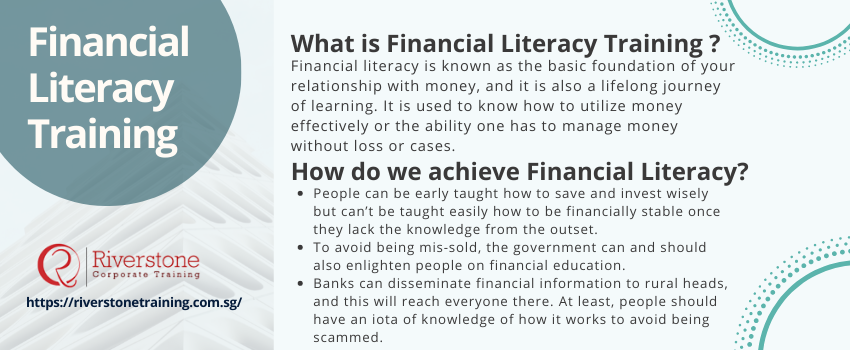
Financial Literacy Training
Introduction
Financial Literacy Training is known as the basic foundation of your relationship with money, and it is also a lifelong journey of learning. It is used to know how to utilize money effectively or the ability one has to manage money without loss or cases. Outcomes of not being able to manage money well turn out to be a bitter one. Financial literacy training, therefore, involves education in practical financial issues such as saving, investing, borrowing, and also evaluating the cost of personal financial services such as insurance, credit for major purchases, and electronic cards
Importance of Financial Literacy
From discoveries, it’s noted that people commit suicide not because they are indisposed but mainly because they’re in a financial imbroglio i.e. bankrupt. A large percentage of the populace lose money to frauds or agents who MIS-SELL because of their Low state of financial education.
The basic importance of financial education is that;
- It is not just increasingly important for investors but has become essential for the average family trying to decide how to balance its budget, buy a home, fund the children’s education and ensure an income when the parents retire from work.
- It helps Individuals to be able to choose the right savings or investments for themselves, which they may be at risk of fraud if they are not financially literate. By taking the initiative to learn financial modeling and investment analysis, individuals gain the skills needed to assess options critically and make informed decisions. They are more likely to save and to challenge financial service providers to develop products that truly respond to their needs, which also should have positive effects on both economic growth and investment levels.
- Some life insurance agents act as frauds to one who is not financially educated by presenting to their goods or services that are costly but of no positive use. Thus, they won’t say every feature the product has. In summary, their frauds can be called ‘MIS-SELLING.’ Understanding how to detect fraud in audit can help uncover such deceptive practices and protect consumers from financial exploitation.
- Financial illiteracy is slack on the government as the cost for financial security rises by the day.
What’s Financial Inclusion?
Financial Literacy Training is best described as the forerunner of financial inclusion which is the crux of the matter. Simply, financial inclusion deals with bringing products or mainly services closer to its citizens at a cheaper rate. Only a financially educated person can know the value of financial inclusion.
Financial inclusion enjoins one to open a bank account, a local one but not only that. It also enjoins one to save money and to invest money. The two (save and invest) are quite different and has to be separated
A financially educated person will open a bank account thereby embracing Financial Inclusion’s advice. Financial education on the other hand supports citizens leaving the state of ignorance i.e. being cheated and defrauded to the state of Financial Literacy Training i.e. embracing Financial Inclusion’s view to ‘save and invest.
A financially educated one questions himself thus. ‘Do I need this product?’, ‘What are the features of this product?’, ‘How can I stop the mis-sell that has been on the rampage?’
Financial education is much better than financial inclusion because people could learn how to save, invest or borrow money in the right way but for financial education, one needs to sit tight and be aware to beware of fraud.
How do we achieve Financial Literacy Training?
Since the orientation about financial education started, one would instinctively know that no one has to be schooled to be literate. And are you puzzled?
The question of how to attain financial education is not a big deal since financial education has been defined as the knowledge a person needs or one has to be able to resist frauds or recognize fraudsters. Therefore, the best way to be financially literate is to be financially educated or informed. Financial education is way better and preferable to financial inclusion as financial inclusion can just be an addition.
When discussing Financial Literacy Training, most minds give reference to the wealthy which is not right. Wealthy people should be professional financial literate to be able to manage their money but for others as well. In fact and in summary, financial education is for all i.e. the rich, the poor, the less privileged, everyone.
To achieve Financial Literacy Training, you need to understand the following;
- People can be early taught how to save and invest wisely but can’t be taught easily how to be financially stable once they lack the knowledge from the outset.
- Anyone who is financially illiterate and embarks on a finance trade will run at a total loss i.e. you must be ‘finance-aware.’
- Banks can disseminate financial information to rural heads, and this will reach everyone there. At least, people should have an iota of knowledge of how it works to avoid being scammed.
- To avoid being mis-sold, the government can and should also enlighten people on financial education.
Advanced Financial Literacy Training for Investing and Wealth Building
Advanced financial literacy training not only teaches people how to use money well, but also lets them start the journey of making investments and acquiring wealth. This will be the deeper branch of financial knowledge touching on advanced principles such as the power of compound interest, risk diversification, and different investment instruments such as stocks, bonds and retirement plan. Training is done on processes of valuation, market forces, and long term financial planning that helps one achieve his or her goals in life. For those seeking structured learning, enrolling in a valuation course for finance professionals can offer the technical knowledge needed to analyze opportunities more effectively. With such high level of financial skills, any individual can make strategic investment and be able to handle financial risks, and also be able to work and create wealth to maintain it—and this will greatly bring financial independence and security issues to the future.
The Impact of Financial Literacy Training on Employee Performance and Business Growth
Training employees on financial literacy is a well thought-out investment that has a considerable influence on personal performance as well as business development. Employees who have sufficient knowledge of fundamental financial terms—including profit, how inventory affects cost of goods sold, and understanding balance sheets for beginners—are more financially responsible and active. Such knowledge enables them to make informed decisions in their roles, identify areas to utilize resources efficiently, and contribute directly to the company’s financial objectives. Employees with financial literacy can run departmental budgets, comprehend the bottom line, and proactively identify and avoid potential risks—ultimately leading to added profitability and a culture of shared financial responsibility in the organization.


